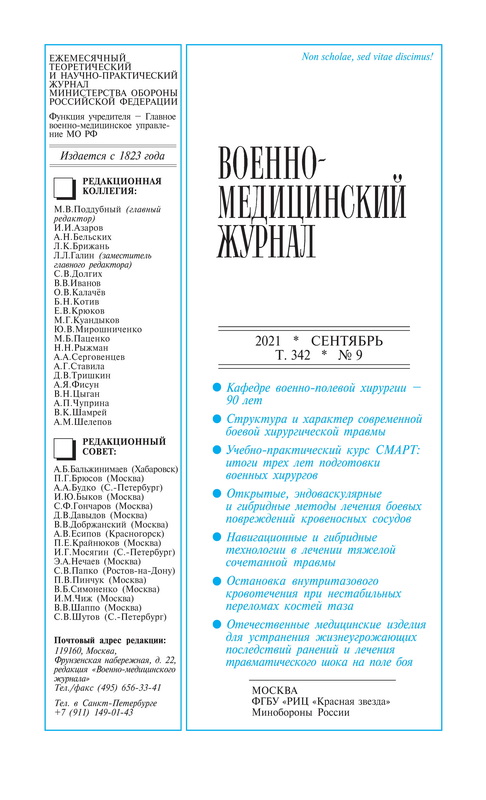Navigational technologies in injury surgery
- 作者: Badalov V.I1, Spitsyn M.I1, Korostelev K.E1, Yarmoshuk R.V1, Shevelev P.Y.1
-
隶属关系:
- The S.M.Kirov Military Medical Academy of the Ministry of Defense of the Russian Federation
- 期: 卷 342, 编号 9 (2021)
- 页面: 30-40
- 栏目: Articles
- URL: https://journals.eco-vector.com/0026-9050/article/view/82653
- DOI: https://doi.org/10.52424/00269050_2021_342_9_30
- ID: 82653
如何引用文章
详细
全文:
作者简介
V. Badalov
The S.M.Kirov Military Medical Academy of the Ministry of Defense of the Russian Federation
Email: vadim_badalov@mail.ru
St. Petersburg, Russia
M. Spitsyn
The S.M.Kirov Military Medical Academy of the Ministry of Defense of the Russian Federation
Email: dr.spicynm2@mail.ru
St. Petersburg, Russia
K. Korostelev
The S.M.Kirov Military Medical Academy of the Ministry of Defense of the Russian FederationSt. Petersburg, Russia
R. Yarmoshuk
The S.M.Kirov Military Medical Academy of the Ministry of Defense of the Russian FederationSt. Petersburg, Russia
P. Shevelev
The S.M.Kirov Military Medical Academy of the Ministry of Defense of the Russian FederationSt. Petersburg, Russia
参考
- Бадалов В.И. Диагностика и лечение сочетанной травмы позвоночника на этапах медицинской эвакуации в условиях военного и мирного времени: Дис.. д-ра мед. наук. - СПб, 2013. - 402 с.
- Гайдар Б.В., Свистов Д.В., Щербук Ю.А. Повреждения черепа и головного мозга // Нейрохирургия. - 2018. - Т. 21, № 23. - С. 37.
- Дулаев А.К. Эффективность централизованной системы оказания специализированной медицинской помощи при острой позвоночно-спинномозговой травме в современном мегаполисе // Хирургия позвоночника. - 2019. - Т. 16, № 1. - С. 8-15.
- Коновалов А.Н., Потапов А.А., Лихтерман А.Б., Кравчук А.Д. Патогенез, диагностика и лечение черепно-мозговой травмы и ее последствий // Вопросы нейрохирургии им. Н.Н.Бурденко. - 1994. - Т. 4. - С. 18-25.
- Крылов В.В. Рекомендательный протокол лечения острой осложненной и неосложненной травмы позвоночника у взрослых (Ассоциация нейрохирургов РФ) // Вопросы нейрохирургии им. Н.Н.Бурденко. - 2014. - Т. 78, № 6. - С. 60-68.
- Орлов В.П., Дулаев А.К. Закрытая травма позвоночника и спинного мозга. - СПб: Фолиант, 2004. - С. 231-233.
- Указания по военно-полевой хирургии / Под ред. А.Н.Бельских, И.М.Самохвалова. - М., 2013. - 474 с.
- Хирургия тяжелых сочетанных повреждений: Атлас / Под ред. В.Е.Парфёнова и А.Н.Тулупова. - СПб: ЭЛБИ-СПБ, 2018. - 458 с.
- Щедренок В.В. Результаты экспертизы качества медицинской помощи при сочетанной позвоночно-спинномозговой травме // Травматология и ортопедия России. - 2010. - Т. 1, № 55. - С. 102-105.
- Gertzbein S.D., Robbins S.E. Accuracy of pedicular screw placement in vivo // Spine. - 1990. - Vol. 15, N 1. - P. 11-14.
- Kakarla U.K., Louis Kim J., Steven Chang W. et al. Safety and accuracy of bedside external ventricular drain placement // Neurosurgery. - 2008. - Vol. 63, N 1. - P. 162-166.
- Magerl F., Aebi M., Gertzbein S.D. et al. A comprehensive classification of thoracic and lumbar injuries // Eur. Spine J. - 1994. - Vol. 3, N 4. - P. 184-201.
- Schatlo B., Molliqaj G., Cuvinciuc V. et al. Safety and accuracy of robot-assisted versus fluoroscopy-guided pedicle screw insertion for degenerative diseases of the lumbar spine: a matched cohort comparison // J. Neurosurg. Spine. - 2014. - Vol. 20, N 6. - P. 636-643.
补充文件






